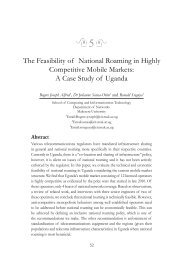Agnes Semwanga Rwashana and Ddembe Willeese Williams_07.pdf
Agnes Semwanga Rwashana and Ddembe Willeese Williams_07.pdf
Agnes Semwanga Rwashana and Ddembe Willeese Williams_07.pdf
Create successful ePaper yourself
Turn your PDF publications into a flip-book with our unique Google optimized e-Paper software.
5.1 Research Questions<br />
Geometrical Spatial Data Integration in Geo-Information Management 149<br />
In order to assess how ICTs may be used to enhance the effectiveness <strong>and</strong><br />
efficiency of the healthcare immunization system, several pertinent questions<br />
were considered:<br />
1. What kind of data <strong>and</strong> information may be collected to underst<strong>and</strong> the<br />
immunization coverage?<br />
2. Which stakeholders provide data <strong>and</strong> use information for monitoring of<br />
the immunization system?<br />
3. How should such an immunization system work?<br />
4. What kind of ICTs may be used to deliver healthcare services?<br />
5. How can these ICT tools <strong>and</strong> techniques be adopted to improve the<br />
management of the Ug<strong>and</strong>an immunization system?<br />
It is these research questions that guided the research design. These experiences<br />
documented in the case studies <strong>and</strong> the cumulative knowledge were used to design<br />
a framework for enhancing immunization coverage.<br />
5.2 Field Studies<br />
Field studies were used to determine the full range of activities <strong>and</strong> challenges<br />
associated with immunization coverage <strong>and</strong> to examine the various acknowledged<br />
factors associated with the provision <strong>and</strong> utilization of immunization services<br />
were carried out. The study area Mukono District, lies in the Central region of<br />
Ug<strong>and</strong>a comprises of four counties <strong>and</strong> has a good representation of both rural<br />
(83%) <strong>and</strong> urban population (17%) with a population density of 264 persons per<br />
sq. Km. Secondly, the people of Mukono district reside both on the isl<strong>and</strong>s (1<br />
county ) <strong>and</strong> the mainl<strong>and</strong> (3 counties) <strong>and</strong> the population of Mukono consists<br />
of more than 18 tribes which would benefit the research by gathering cultural<br />
beliefs <strong>and</strong> opinions from the various tribes. The study was analytical; involving<br />
the various stakeholders who are important as far as the immunization system is<br />
concerned.<br />
Mothers - In each county of the selected district, 200 mothers were interviewed.<br />
Multi-stage sampling method was used to select target sample size of 800 mothers.<br />
The sample size was determined as follows: Since many variables were being<br />
measured, a prevalence of 50 percent, which dem<strong>and</strong>s the largest sample size was<br />
used. At 95% confidence interval with the immunization coverage (p) of 70% <strong>and</strong><br />
level of permissible error (e) as e ≤ 10% the sample size n was determined by the<br />
following equation:<br />
z<br />
2<br />
pq<br />
n =<br />
e<br />
2<br />
………….….….Equation 1<br />
where p=0.7, q=(1-0.7)=0.3, z = 1.96 <strong>and</strong> e= 0.1
















